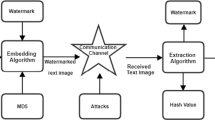Abstract
A novel watermarking technique for the tamper detection of English text images is proposed in this paper. The frequency of maximum occurring vowel in every sentence is counted and converted to Unicode Zero Width Characters (ZWCs) by using a lookup table. These ZWCs and total length of each sentence are added at the end of the sentence. ZWCs of the Hash value of the cover text is calculated and inserted at the end of the cover text. These values are extracted from the received data on the receiver side for the tamper detection. The hash value of the received text as well as frequency of maximum occurring vowel of each sentence are again calculated and compared to their extracted corresponding values to prove the authentication of the image. Comparison with existing state-of-the-art techniques shows the effectiveness of the proposed technique.







Similar content being viewed by others
Data Availability
Data sharing not applicable to this article as data availability statement in my main manuscript.
References
Ahvanooey, M. T., Mazraeh, H. D., & Tabasi, S. H. (2016). An innovative technique for web text watermarking. Information Security Journal: A Global Perspective, 25, 191–196.
Ahvanooey, M. T., Li, Q., Zhu, X., Alazab, M., & Zhang, J. (2020). ANiTW: A novel intelligent text watermarking technique for forensic identification of spurious information on social media. Computers & Security, 90, 1–14.
Alotaibi, R. A., & Elrefaei, L. A. (2017). Improved capacity Arabic text watermarking methods based on open word space. Journal of King Saud University-Computer and Informatics Sciences, 30, 236–248.
Al-Maweri, N. A. S., Adnan, W. A. W., Ramli, A. R., Samsudin, K., & Rahman, S. M. (2016). Robust digital text watermarking algorithm based on Unicode Extended Characters. Indian Journal of Science and Technology, 9, 1–14.
Al-Wesabi, F. N., Mahmood, K., & Nemri, N. (2020). A zero watermarking approach for content authentication and tamper detection of Arabic text based on fourth level order and word mechanism of Markov Model. Jorunal of Information Security and Applications, 52, 1–15.
Cao, F., An, B., Wang, J., Ye, D., & Wang, H. (2017). Hierarchical recovery for tampered images based on watermark self-embedding. Displays, 46, 52–60.
Gonzalez, M., Nakano-Miyatake, M., Perez-Meana, H., & Sanchez-Perez, G. (2015). Script format document authentication scheme based on watermarking techniques. Journal of Applied Research and Technology, 13, 435–442.
Khosravi, B., Khosravi, B., Khosravi, B., & Nazarkardeh, K. (2019). A new method for pdf steganography in justified texts. Journal of Information Security and Applications, 45, 61–70.
Mohamed, A. A. (2014). An improved algorithm for information hiding based on features of Arabic text: A Unicode approach. Egyptian Informatics Journal, 15, 79–87.
Naqvi, N., Abbasi, A. T., Hussain, R., Khan, M. A., and Ahmad, B. (2018). “Multilayer partially Homomorphic encryption text steganography: A zero steganography approach”, Wireless Personal Communications, pp. 1563-1585.
Patiburn, S. A., Iranmanesh, V., & Teh, P. L. (2017). Text steganography using daily emotions monitoring. International Journal of Education and Management Engineering, 3, 1–14.
Por, L. Y., Wong, K., & Chee, K. O. (2011). UniSpaCh: A text-based data hiding method using Unicode space characters. The Journal of Systems and Software, 85, 1075–1082.
Qin, C., Chang, C., and Hsu, T. (2013). Effective fragile watermarking for image authentication with high-quality recovery capability, KSII Transactions on Internet and Information Systems, vol. 7, pp. 2941-2956.
Rivest, R. (1992).“The MD5 message-digest algorithm”, RFC 1321.
Rizzo, S. G., Bertini, F., and Montesi, D. (2016). Content-preserving text watermarking through unicode Homoglyph substitution, in Proceedings of International Database Engineering and Applications Symposium, pp. 97-104.
Rizzo, S. G., Bertini, F., Montesi, D., and Stomeo, C. (2017). Text watermarking in social media. in Proceedings of International Conference on Advances in Social Networks Analysis and Mining, IEEE/ACM, pp. 208-211.
Rizzo, S. G., Bertini, F., & Montesi, D. (2019). Fine-grain watermarking for intellectual property protection. Journal on Information Security: EURASIP, pp. 1–20.
Yang, S., Qin, C., Qian, Z., and Xu, B. (2014). Tampering detection and content Recovery for digital images using halftone mechanism. in Proceedings of International Conference on Intelligent Information Hiding and Multimedia Signal Processing, IEEE, pp. 130–133.
Funding
No funding was received.
Author information
Authors and Affiliations
Corresponding author
Ethics declarations
Conflict of interest
The authors declare that they have no conflict of interest.
Additional information
Publisher's Note
Springer Nature remains neutral with regard to jurisdictional claims in published maps and institutional affiliations.
Rights and permissions
Springer Nature or its licensor (e.g. a society or other partner) holds exclusive rights to this article under a publishing agreement with the author(s) or other rightsholder(s); author self-archiving of the accepted manuscript version of this article is solely governed by the terms of such publishing agreement and applicable law.
About this article
Cite this article
Singh, B., Hathwal, R.P. Tamper Detection Technique for Text Images based on Vowels and Unicode Zero Length Characters. Wireless Pers Commun 132, 2421–2436 (2023). https://doi.org/10.1007/s11277-023-10724-6
Accepted:
Published:
Issue Date:
DOI: https://doi.org/10.1007/s11277-023-10724-6




